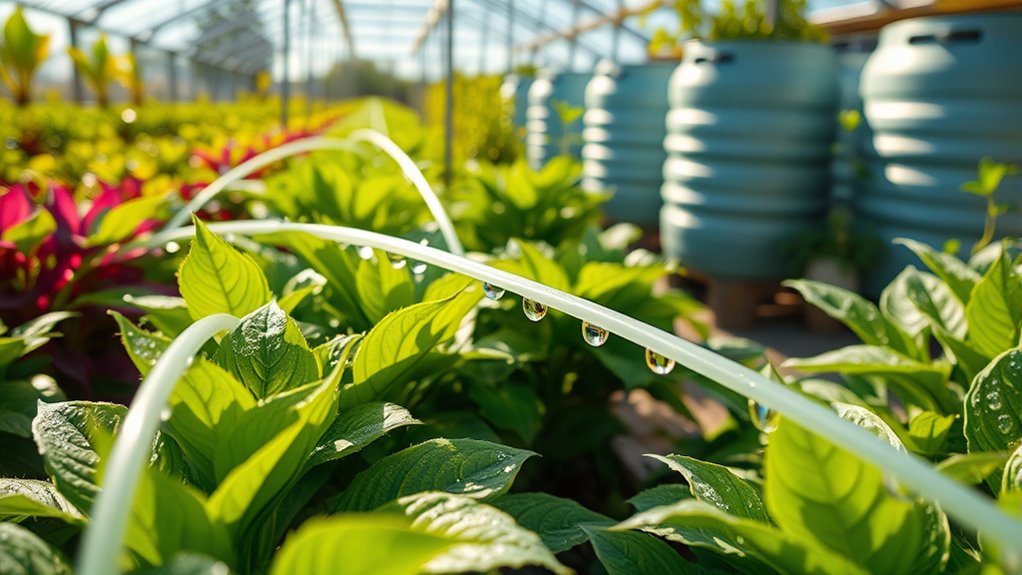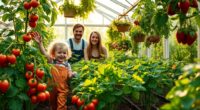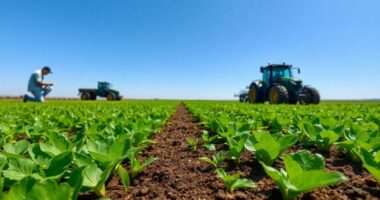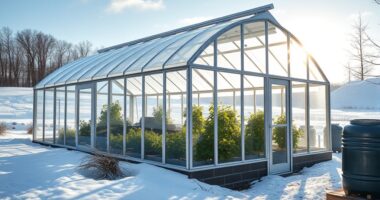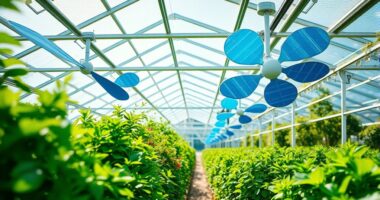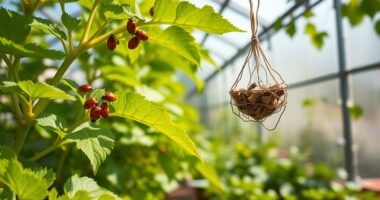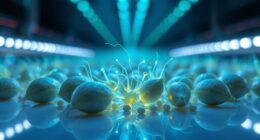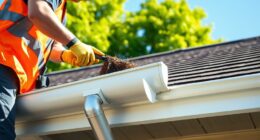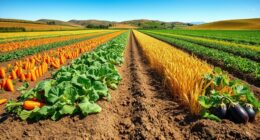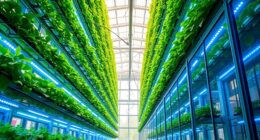To conserve every drop in your greenhouse, integrate rainwater harvesting with soil moisture sensors and automated irrigation. Collect rainwater for consistent, eco-friendly watering while sensors monitor soil moisture levels in real-time. This combination prevents over- and underwatering, reducing water waste and promoting healthy plant growth. Regular maintenance guarantees all systems run smoothly, maximizing efficiency. Keep exploring these smart techniques to create a truly water-wise greenhouse environment that’s sustainable and cost-effective.
Key Takeaways
- Implement rainwater harvesting to supply sustainable, renewable water for greenhouse irrigation needs.
- Use soil moisture sensors to optimize watering schedules and prevent over- or underwatering.
- Integrate automated irrigation systems with sensor data for precise, hands-free watering control.
- Regularly maintain and calibrate sensors and irrigation equipment to ensure efficiency and accuracy.
- Combine rainwater collection with soil moisture monitoring for a comprehensive, eco-friendly water conservation strategy.
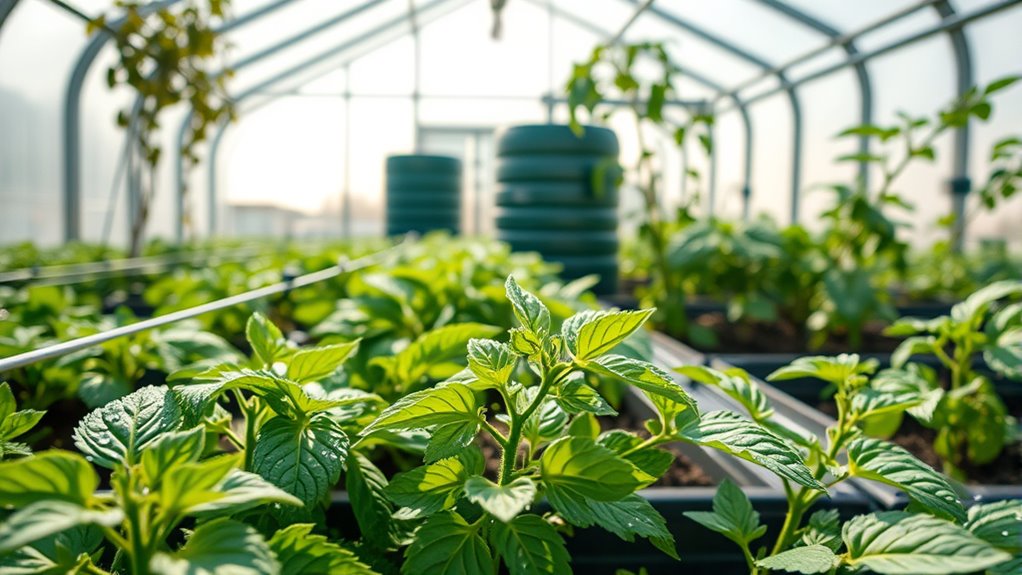
In addition to rainwater harvesting, integrating soil moisture sensors into your greenhouse helps you water more precisely. These sensors measure the moisture level of your soil in real-time, giving you accurate data on when watering is necessary. With this technology, you avoid overwatering, which can lead to water wastage and plant health issues, and underwatering, which stresses your plants. Soil moisture sensors are straightforward to install and can be connected to automated irrigation systems, making watering a hands-free, efficient process. They enable you to tailor watering schedules based on actual soil conditions, not just estimates or timers, ensuring your plants get the right amount of water every time. Regular maintenance of sensors and irrigation systems is essential to maintain accuracy and efficiency, preventing performance decline over time.
Using rainwater harvesting combined with soil moisture sensors creates a sustainable cycle that minimizes waste. When you harvest rainwater, you’re utilizing a natural, renewable resource, and soil moisture sensors ensure that this resource is used wisely. Instead of watering on a fixed schedule, you respond to your plants’ actual needs, reducing unnecessary runoff and evaporation. This approach not only conserves water but also promotes healthier plant growth by preventing overwatering and soil saturation. It’s a smart way to manage your greenhouse’s water use, especially during droughts or in areas with limited water supply. Incorporating water-saving technologies like these can significantly enhance your sustainable gardening practices.
Frequently Asked Questions
How Can I Measure My Greenhouse’s Water Efficiency?
To measure your greenhouse’s water efficiency, start by tracking your water usage through audits. Use soil moisture sensors to monitor the moisture levels in your soil, ensuring you’re not overwatering or underwatering. Regular audits help identify areas for improvement, while sensors provide real-time data. Combining these methods allows you to optimize water use, reduce waste, and create a more sustainable and efficient greenhouse environment.
What Are the Best Drought-Resistant Plants for Greenhouses?
Did you know that drought-resistant plants can reduce water use by up to 70%? When choosing plants for your greenhouse, consider succulent varieties like aloe vera or jade plants, which thrive with minimal water. Native plants are also excellent because they’re adapted to your local climate and need less watering. These choices help conserve water while keeping your greenhouse lush and healthy.
How Does Climate Affect Water Conservation Strategies?
Climate variability considerably impacts your water conservation strategies. You need to make seasonal adjustments, such as increasing water efficiency during dry periods and reducing it when rainfall is abundant. Understanding local climate patterns helps you optimize watering schedules and choose drought-resistant plants. By adapting your approach to these changes, you guarantee your greenhouse remains sustainable, conserving water effectively regardless of weather fluctuations.
Can Rainwater Harvesting Boost Greenhouse Water Savings?
Did you know that rainwater harvesting can reduce outdoor water use by up to 50%? Yes, it can markedly boost your water conservation efforts in the greenhouse. By collecting and storing rainwater, you create a sustainable source that minimizes reliance on municipal water supplies. This simple technique not only saves water but also lowers your bills and environmental impact. Incorporate rainwater harvesting to make your greenhouse more eco-friendly and water-efficient.
What Are Cost-Effective Water-Saving Technologies for Greenhouses?
You can save water in your greenhouse by implementing cost-effective technologies like drip irrigation, which delivers water directly to plant roots, reducing waste. Mulching techniques also help retain soil moisture and minimize evaporation. These methods are affordable, easy to install, and effective, ensuring you use water efficiently. By adopting drip irrigation and mulching, you’ll reduce water bills and support sustainable greenhouse practices.
Conclusion
By embracing water-wise techniques, you conserve a precious resource often taken for granted. While greenhouses symbolize growth and abundance, they can also quietly drain water resources if not managed wisely. Balancing lush productivity with mindful water use transforms your greenhouse into a sustainable haven. Ultimately, conserving every drop isn’t just about saving water; it’s about nurturing the environment and ensuring future growth, even when it seems like there’s plenty to spare.
